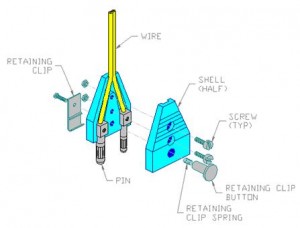One common asked question is what are the different types of body cords and which is better. While many people approach this with an almost religious fervor, the simple fact is that there are several different types of body cords, and each has its own advantages and disadvantages.
German Style Body Cords
The German style two-prong is probably the most common system in the world. The socket is simple to manufacture and maintain, so it is relatively cheap and simple to maintain. The German style two-prong plug on the other hand tends to require more maintenance and it has lots of small parts when you take it apart. The expanded metal spring portion of the pins gets compressed over time, sometimes allowing breaks in contact between the pin and socket (resulting in intermittent white lights). The hard plastic shell may hold the pins securely but it also forms a hard point where the wire comes out the top which is where the wire usually tends to fail.
The integral retaining clip on the German plug usually works well keeping the plug from pulling out of the socket however from time to time you have to check that the screw holding it together is tight – otherwise it eventually comes out and the whole retaining mechanism flies apart.

The German design has been widely copied. The quality of these copies can vary drastically, anywhere from excellent to complete garbage. The most notable variation probably comes from Favero, where they replace the metal retaining clip and spring with a plastic one. These are a little less prone to fly apart however the plastic clip will eventually break and last time I checked Favero wasn’t selling replacement clips so you have to buy a new plastic shell just to get a replacement clip.
French Type Plug and Socket
The French type two-prong socket (Prieur) is similar to the German but the metal bracket is slightly smaller so the retaining clip on a German body cord often won’t catch on the bracket. French two-prong plugs are probably among the simplest of plugs out there – a single block of plastic and two pins held in place by the same screws that connect the wires to the pins. They tend to be very cheap and easy to maintain but they still suffer from the problem of the pins compressing over time and not always maintaining good contact. However the biggest disadvantage of the French system has to be its retaining mechanism – a plastic clip fitted onto the socket that is supposed to fit over the body cord plug. These plastic clips rarely fit as well as they should and tend to break at the worst possible moment. Most people stay away from them for just that reason.